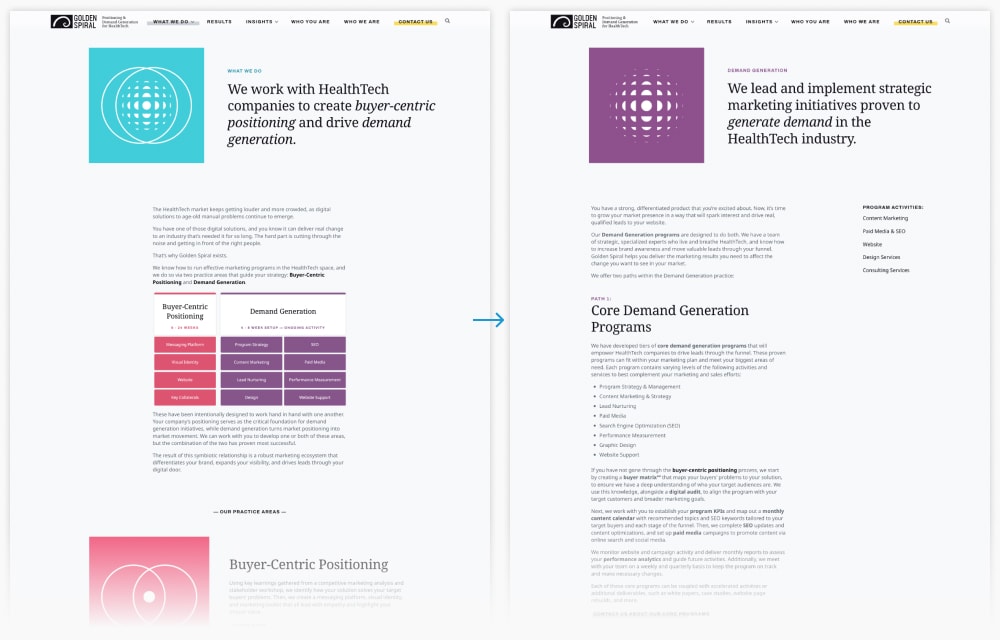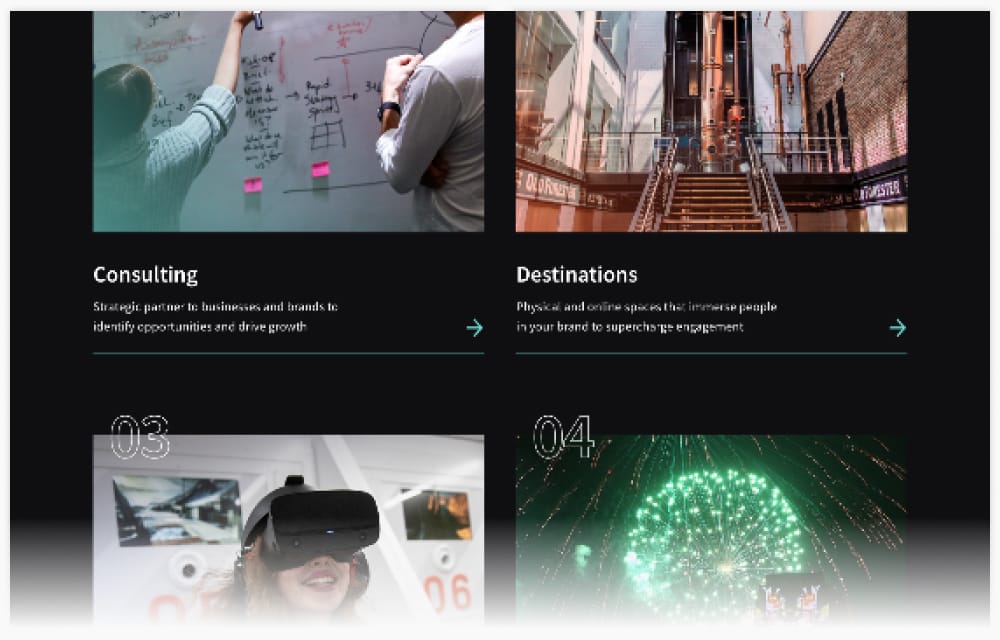A service page strategy is how you explain the structure of your business for prospects. Your positioning statement may tell prospects what you can do and whether it’s for them, but they need to know more than that. They need to know what specific problems you can help them solve, and what results to expect.
This is the job of positioning pages – a concept I’ve written about elsewhere – which include the home page, an offering overview, individual service pages, and pages that describe results. Together, they will guide a prospect to a more full understanding of your expertise and create a demand for it. That’s what Prospect Experience Design (PX) is all about.
(There is a lot of information about Prospect Experience Design (PX) on this website; if PX is new to you, I recommend reading through it before you continue here.)
Services Should Define, Differentiate, and Create Demand
But what do I mean by “service” pages? Most of my clients don’t actually sell services in the strict sense. They don’t offer a la carte options where a customer could buy Service A, B, C, and so on, or a combination of them at their discretion. Most of the time, “service” is a catch-all term for the way the structure of an expertise-driven business is expressed. There are many different ways that professional “services” can be expressed, organized, and understood. But which is best?
Defining Your Service Page Strategy
On the one hand, the question could seem overly academic. After all, if a prospect sees something in the ballpark of their understanding or needs – regardless of whether “services” read more like steps in a process, capabilities, disciplines, etc. – it will probably get them to stick around and perhaps even get in touch. But on the other hand, probably and perhaps aren’t good enough. A clear service page strategy begins with understanding a service page’s purpose. A service page’s purpose is to define, differentiate, and create demand for your expertise. If it does this then it will be the direct source of most of your best inquiries.
A prospect should not feel like they’re in the right ballpark when reading your service pages. They should know that they have come to the one and only place for them – that what you do is exactly what they need in order to move forward. That could be because you describe their problem in a way that makes them believe that no one understands it better than you. Or, because you combine solutions in a way that no competitor does. Or, because you describe the results to which you hold your work accountable so specifically that your prospect concludes that they simply can’t afford to not hire you. It should be because of all of the above.
What I’d like to offer you here is a little bit of direction in this task, which is partly business strategy, partly marketing, partly copywriting, and partly design. That’s what makes this hard; you need to adopt multiple points of view and move fluidly between them in order to identify the right structure for your expertise.
Service Pages Should Be Simple
What is the difference between a service and a capability? It’s very simple. A service is what you put on an invoice; a capability is what you put in a project management app.
It really is that simple. But let me explain why. I’ll start by explaining why the most common approaches don’t work.
Prospects Don’t Buy Processes
In lieu of a real service page strategy, most companies that sell professional services take a procedural approach to organizing them on their websites. They list out steps in a process as a means to sell their expertise. This is ineffective for two reasons.
First and foremost, processes are mostly proprietary in name only. A savvy prospect – one who has already worked with an expert in your space or is at least comparing you to other options – will sniff out the BS of a “proprietary process” right away. You can come up with a fancy name. You can trademark whatever you like. But the steps all still sound the same because they generally are. And that’s what brings me to the second reason: What prospects want to buy are outcomes, not steps. If a prospect believes in your ability to deliver results, they probably won’t care much about the recipe. At least not at the opportunity stage.
Prospects Don’t Buy Capabilities
Another common service page strategy is to create an extensive list of capabilities. I think of a capability as a “thing you can do.” A capability is not a problem or a solution, really, and simply listing them runs the risk of appearing as if you’re selling labor. An expert does not sell labor and a good prospect for an expert isn’t looking to buy it.
This is why most experts who sell capabilities play (mostly unintentionally) semantic games with them. When capabilities are marketed like something else, they tend to fail as an organizational framework. As a group, they become an unhelpfully mixed bag.
“Capabilities” are often:
- disciplines talked about as if they’re products (e.g. Strategy)
- experiences that are a means to an end (e.g. Journey Mapping)
- deliverables (e.g. Prototypes)
- pedagogy (e.g. everything you must do to achieve X)
The list of most true experts’ capabilities will be long, complex, and diverse. That’s not a bad thing. But putting that list front-and-center in your marketing is not effective. Of the four examples above, a pedagogical approach is probably the most useful, as it comprises a single point of view on a prospect’s situation. But, it still tends to fail because it brings too much complexity to the surface too soon. A good service page strategy is confidently simple. Prospects need and respect simplicity! Just like us, they have limited attention and they won’t act if there is too much information to sift through.
Services Are Promises of a Desired Future State
The best definition of a service for someone selling expertise is this: A service is a grouping of capabilities leveraged at your discretion in order to lead to your client’s desired future state.
It’s OK if a prospect comes to you wanting to buy a capability, but it’s not OK if that’s what you end up selling to them.
That means that “everything” is not a service page strategy. Remember, service pages are marketing and sales tools. They’re not client handbooks. They don’t need to describe the operational reality for a future client. They need to describe just enough to create demand. A healthy engagement is highly customized anyway, which is what I’m getting at with “at your discretion.” You may list several capabilities under the name of a service, but you must also retain the ability to apply them if and when they will achieve your client’s goals without those things being misunderstood as what they have paid for.
When services are structured according to this simple definition, they’re most often named either for their main discipline (e.g. Branding or Design) or their objective (e.g. Product Development). This can work. But I prefer at least trying to give them a “proper,” keyword-rich name that affords you some creative pricing options (e.g. programs to which clients subscribe). This approach is basically a segue into sales. It helps to mitigate sticker shock, decouple invoices from milestones, and perhaps even move accounts into performance pricing at regular intervals.
Three Examples of Expert Service Pages that Define, Differentiate, and Create Demand

Golden Spiral Marketing
Golden Spiral’s service page strategy is deceptively simple. On their offering overview, Golden Spiral list only two core practice areas within the HealthTech industry. They offer Buyer-Centric Positioning and Demand Generation. Both comprise a variety of programs and activities that are clearly organized and written with a focus on outcomes. They also list specific program activities that are capability and deliverable-oriented. This is a good way of signaling to a term-scanning prospect that doesn’t undercut the positioning emphasis of the service structure itself.

Imagination
As a creatively-driven experience design firm, Imagination takes an interesting approach to aligning their expertise with prospect needs. Rather than breaking down experience design into pedagogy, dividing by discipline, or describing deliverables, Imagination organizes their expertise by context. This is very smart, as the very nature of experience design is entirely shaped by context. Their core structure of Destinations, Content, and Live describes the contexts in which their expertise is most effectively applied.

Impact
On their home page, Impact lead with a three-part framework for how they train large enterprise marketing teams: Strategies, Skills, and Systems. Here, they’re framing their positioning with simple terminology suited to their point of view. But they understand that these words won’t necessarily align with the needs of all their prospects as they understand and describe them. That’s why they immediately follow that introduction with a list of the most common terms that prospects ask them about.
Under the heading “Help Where You Need it Most,” Impact list a diverse group of challenges, experiences, deliverables, and outcomes. Each neatly fits into their Strategies, Skills, and Systems schema. What makes this compound positioning and service structure so effective is that it both establishes a simple, point-of-view driven business structure while also giving prospects an open door on their terms. Both take prospects to the same place: Impact’s offering overview page. That creates a level of control over flow that ensures prospects see the right information in the right order prior to getting in touch.
There Is No One Service Page Strategy
There is no one way to do this, but there is one single purpose: clarity. A prospect must understand the structure of your business in order to understand your expertise, how it will help them, how they will experience it, and how they will pay for it.
If your service pages don’t do that, then they need work.
